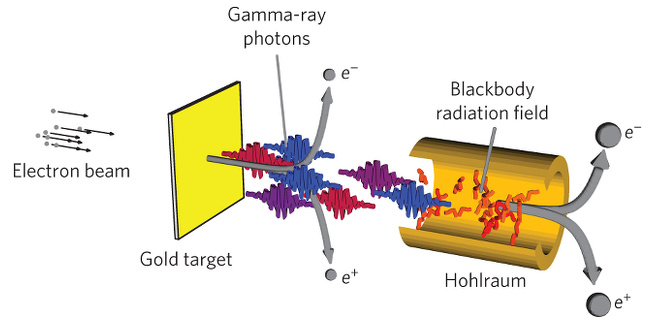A trio of theoretical physicists reckon scientists will be able to make matter out of pure light* within the next year using today's technology.

The idea of making matter out of light sounds far-fetched, but it's an important prediction from the theory of quantum electrodynamics, and it's the same process that was in play during the first hundred seconds of the Universe.
In 1934, two US scientists – Gregory Breit and John Wheeler – described a theoretical way of how simply smashing together two photons would create an electron and a positron, although they wrote at the time that they thought it unlikely it would be achieved in a lab.
The pair of physicists reckoned this would be the very simplest method to turn light into matter. The maths worked out, but the technology just didn't exist to attempt an experimental proof.
Now boffins from Imperial College London, and one from Germany's Max Planck Institute for Nuclear Physics who was visiting the UK, claim to have come up with a way to do it in just one day "over several cups of coffee".
They were working on fusion energy, but realised that their work could be applied to the Breit-Wheeler theory. They propose a new kind of high-energy physics experiment – a photon-photon collider. First, scientists would use an extremely powerful high-intensity laser to speed electrons up to just below the speed of light. Firing these electrons into a slab of gold would create a beam of photons a billion times more energetic than visible light.
To complete the collider, boffins would need a tiny gold hollow cylindrical shell known as a hohlraum (from the German for "empty room"). Another high-energy laser would be fired at the inner surface of the hohlraum to create a thermal radiation field that generates light similar to that of the stars. Shooting the first photon beam through the container and the field would cause the photons from the two sources to collide and form electrons and their antimatter equivalent, positrons.
The boffins reckon they should be able to get around 100,000 of the pairs in a single shot, which could be detected as they exited the hohlraum. Demonstrating the Breit-Wheeler theory would be the final piece of research needed to describe the simplest ways light and matter interact and help to solve one of physics' greatest mysteries - gamma ray bursts, the biggest explosions in the Universe.
"Despite all physicists accepting the theory to be true, when Breit and Wheeler first proposed the theory, they said that they never expected it be shown in the laboratory. Today, nearly 80 years later, we prove them wrong," said Professor Steve Rose.
"What was so surprising to us was the discovery of how we can create matter directly from light using the technology that we have today in the UK. As we are theorists we are now talking to others who can use our ideas to undertake this landmark experiment."
Their paper has been published in Nature Photonics. ®
* It's worth noting that "experimental signatures" of matter from light have been detected in the past, as the authors of the paper point out, but only with the use of "massive particles" in conjunction with laser beams. Should the experiment work, it will be the first time that matter is created from "pure light" (ie, photon-on-photon action).
Source : http://www.theregister.co.uk/2014/05/19/photon_collider_light_into_matter/